Singlehanded Sailing Gets a Fun Injection
Published on August 1st, 2017
The death grip held by the Laser class on singlehanded sailing is being challenged as the Melges 14 and RS Aero gain traction. With the first ever RS Aero World Championship attracting 96 sailors from 16 nations, Scuttlebutt editor Craig Leweck reached out to division winner Marc Jacobi (USA) for an update.
You are a long time Laser sailor. Why now the Aero?
I’d heard about the Aero, but never seen it sailed by anyone I knew, against good Laser sailors. Our local dealer, Boat Locker, lent me a rigged demo boat with the mid-sized sail, and with an hour of sailing under my belt, I went out with my local Laser frostbiting fleet in Westport, CT and won all but one race in 3-8 knots of breeze.
This 37-boat fleet included 2012 US Olympic Laser representative Rob Crane, and I couldn’t believe how the boat accelerated, how it just took off onto a plane when cracked off 10 degrees from close-hauled, how the beautiful blades didn’t hum, how easy it was to drag up the beach (85 lbs all-up). I was hooked!
How was the sailing at the Worlds?
It was so much fun! As this was the first Worlds, I had no idea what the level of competition would be or what people would be like. All the top Europeans were to be at Worlds, so I worked hard with my training partner Madhavan Thirumalai (USA) to get boathandling and speed as good as possible in a wide range of conditions. The Worlds itself was windy, but the practice race was very light and the two of us were 1, 2 when it was abandoned, so our work obviously paid off.
The biggest surprise was how lovely the people were. It’s a family boat for many in Europe, so in a number of cases Mom, Dad and the kid were all racing. Lots of smiles, daily prizes from sponsors Rooster Sailing, Ron Abuelo rum, and SpeedSix, great social activities ashore, and dinners with new friends off-site. I led a daily stretching session at the end of each day. There was something for everyone, no matter where you were in the fleet. It felt a lot like my prior class did before it went Olympic and got as serious as a heart attack.
The Aero appears to have momentum. Is this more about the well-documented problems with Laser or more about people eager for an alternative?
It may have started with the other boat’s problems, but I see the Aero as a real alternative. People want to go fast, have fun and not deal with hassles. The Aero nails all three. It really is a fantastic boat. A tremendous amount of thought and engineering has gone into it. The whole boat shows such attention to detail. It’s super-easy to rig, the sails last a long time, hardly anything breaks (we had a windy Worlds and not one spar failure), and if it does, the factory is right on it fixing things so it doesn’t happen again.
Starting new classes is one of the biggest gambles we see in the sport. Why will the Aero succeed?
Because it’s a great boat unto itself. It has tremendously strong support from builder RS (the largest dinghy manufacturer in Europe). And the people sailing it are forward-thinking, fun folks who are passionate about it.
I think the Aero would make a great step-up boat for young sailors aging out of Opti-size trainers. The hull only weighs 66 pounds so it’s MUCH more fun and responsive to sail than the Laser 4.7 or Radial That it’s so much easier to drag around the boatpark, put on top of a car, and they stack up to 5-hulls high are all added bonuses that Juniors and programs would appreciate.
The class has three rig options. Is there a consensus for sailor sizes?
That really depends on the wind and skill set of the sailor. In Europe, people generally purchase two rigs and decide at the regatta which one to use based on conditions. But if I had to come up with a range, it would be:
RS Aero 5 – 100-150 pounds
RS Aero 7 – 130-190 pounds
RS Aero 9 – 160-225 pounds
The 9 is a weapon under 10 knots. The 7 has a more flexible bottom section and is surprisingly close in speed in over 12 knots. And the 5 (which I’ve only sailed once for any length of time) probably has the nicest sail shape of all. All three are beautifully balanced due to different bottom sections and sails specifically designed to use them.
For such a light boat, it handles weight variances very well. I think this may be due to the hull chine. As overall weight goes up, wetted surface doesn’t increase nearly as quickly as with dish-shaped hulls. Of course, a heavier sailor will suffer in marginal surfing conditions, but the Aero surfs so quickly the marginal wind-band is small. For lighter sailors, the rig depowers beautifully, so it’s easy to handle as things pipe up.
What’s next for the class?
RS has a 10-boat demo trailer that goes all around the country turning people onto the boat (www.RSAeroSailing.org/NAtour). The next stops are Hempstead Harbor YC (Long Island) mid-August, then Lake Massapoag (Sharon, MA) in September before heading south. The 2018 Worlds will be in Weymouth (the boat has taken off in the UK–they regularly get 50+ boats at regattas), and 2019 will be in North America.


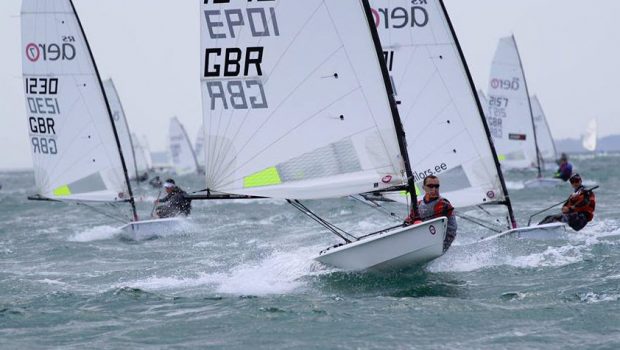
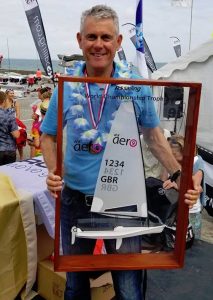


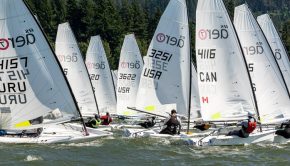
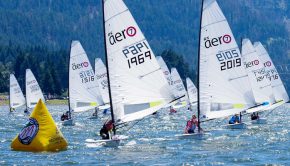
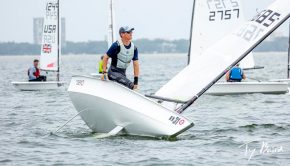
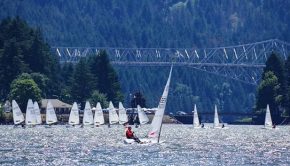
 We’ll keep your information safe.
We’ll keep your information safe.